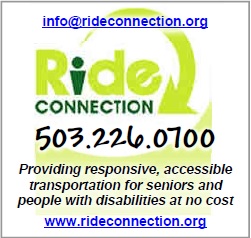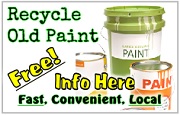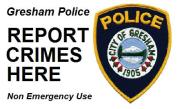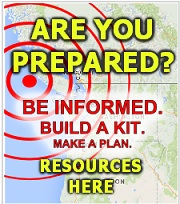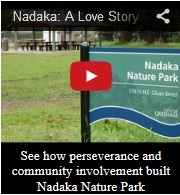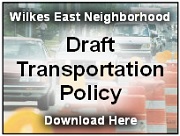When A Natural Emergency Strikes Will You and Your Family Be Ready?
Experts Warn Cascadia Is Overdue For A 9.0 Earthquake
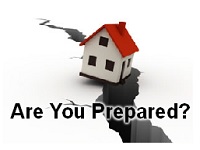
|
Be informed.
|
If you're like most of us - you're not ready.
If that's you, we've got some great tips and valuable resources below to help you be prepared for whenever a disaster strikes.
CONTENTS
- TICK. TOCK.
- AS SOON AS YOU FEEL THE SHAKING
- HOW WILL WE GET AROUND?
- WHAT WILL WE DRINK?
- WHERE WILL WE POO?
- WHAT WILL WE EAT?
- MAKE A PLAN
- BUILD A KIT
- MORE RESOURCES
TICK. TOCK.
Think of Oregon geology as a clock, measuring time in earthquakes. Tick: a magnitude 8 quake. (Bigger than 1989 Bay Area quake that killed 63 people.) Tock: a magnitude 9 quake. (Same as the 2011 Japan quake that killed almost 16,000 people.) On average, a major quake happens in our area every 243 years, the last one was January 26, 1700 — 316 years ago. Yes. We are overdue.
Hillsides will slide. Buildings will collapse. Roads will buckle. High-rises will sway. Bridges will crack. Some will fall. Pipes will snap. Within 20 minutes, the first of several 40-foot tsunami waves will wash away the Oregon Coast’s low-lying towns.
If our next “subduction zone” quake unleashes its full potential, it will be the worst natural disaster in U.S. history. But there are crucial steps we can take as individuals. Preparation may mean the difference between finding your loved ones or not; between sleeping inside your mildly damaged house or on a cot in a refugee center; between going hungry and thirsty for days or managing until supplies arrive. And, between living and dying.
AS SOON AS YOU FEEL THE SHAKING
- DROP down onto your hands and knees before the quake knocks you down
- COVER your head and neck with your arms to protect yourself from falling debris or get under a desk or table.
- HOLD ON to any sturdy covering so you can move with it until the shaking stops.
When the shaking stops get outside away from buildings.
HOW WILL WE GET AROUND?
By foot, bike, and boat, mostly. People will be stuck where they are for quite some time. Prepare to bond with the people you’re with - whoever they are - or get walking. Get some bikes. Fuel might be tight for days, even months, so keep your vehicle full.
WHAT WILL WE DRINK?
Your faucets (and toilets) will be dry for weeks, maybe months. The Bull Run dams are expected to survive, but many water mains are brittle cast iron. Reservoirs will crack; treatment facilities and pump stations will fail. For the first few weeks, water will have to be pumped, purified, and trucked. (Tip: you can make water safe by using 16 drops of regular (unscented) household liquid bleach per gallon of water. Wait 30 minutes.)
WHERE WILL WE POO?
The Portland group Public Hygiene Lets Us Stay Human (phlush.org) has an emergency “two bucket” toilet system to maintain hygiene -- like those used in New Zealand after the 2011 quake. It’s safe and manageable. And you can store your other emergency supplies inside the buckets until needed.
WHAT WILL WE EAT?
The quake will shake the whole Northwest, from British Columbia to California. Grocery and “big-box” stores are likely to suffer severe damage. Bridges, highways, and railroad lines may not be passable. Create an inventory of several weeks of non-perishable food. Stock up now.
HOW MUCH FOOD DO I NEED?
Here's how to calculate your Disaster Pantry food requirements:
Step 1: CALCULATE YOUR BMR
You use energy no matter what you're doing, even when sleeping. This BMR Calculator will calculate your Basal Metabolic Rate (BMR); the number of calories you'd burn if you stayed in bed all day.
Step 2: CALCULATE YOUR DAILY CALORIE NEEDS
To determine your total daily calorie needs, multiply your BMR by the appropriate activity factor as follows:
- IF YOUR ARE SEDENTARY
(little or no exercise) :
Daily Calories = BMR x 1.2 - IF YOUR ARE LIGHTLY ACTIVE
(light exercise/sports 1-3 days/week) :
Daily Calories = BMR x 1.375 - IF YOUR ARE MODERATELY ACTIVE
(moderate exercise/sports 3-5 days/week) :
Daily Calories = BMR x 1.55 - IF YOUR ARE VERY ACTIVE
(hard exercise/sports 6-7 days a week) :
Daily Calories = BMR x 1.725 - IF YOUR ARE EXTRA ACTIVE
(very hard exercise/sports & physical job or 2x training) :
Daily Calories = BMR x 1.9
(Tip: Increase your daily total by 500-1000 calories as a cushion)
Step 3: CALCULATE YOUR MONTHLY CALORIE NEEDS
Monthly Calories = Daily Calories x 30 days
|
CALORIES FOR A MODERATELY-ACTIVE FAMILY OF FOUR
|
MAKE A PLAN
First make a plan for your family, taking into account different scenarios, such as if the quake were to strike during the work or school day. Establish a meeting point if family members are away from home. Plan how you will communicate with family members (text messages may be best). Secure items that might fall and cause injuries (ie. TV's, bookshelves, mirrors, pictures, cabinets, light fixtures, water heaters). Practice DROP, COVER, and HOLD ON. Store critical supplies and documents. Download this free Map Your Neighborhood kit, and print these American Red Cross Emergency Contact Cards for each household member.
BUILD A KIT
Don't think that your kit must immediately be perfect. Many of the items you need are probably lying around the house. You can add to the kit as time and money allow. Download this free brochure that shows you how to assemble a robust emergency kit in 12-weeks purchasing or collecting a few items each week. Store everything inside plastic buckets and tote bins with lids.
Find a good place to keep your kit. A garden shed or garage makes a great choice over storing your kit in an inside closet.
Check-out these great kit lists:
POCKET FIRST-AID KIT
Everybody should have one of these kit available
- bandages
- antiseptic wipes
- neosporin (antibiotic)
- plastic mirror
- iboprofen / tylenol / excedrin
- antihistimine (benedryl)
- antacid tablets
HOME KIT
This kit is your personal store during a disaster. Store everything inside stacking plastic buckets and tote bins with lids.
- Nonperishable packaged or canned food (heat-n-serve, or ready-to-eat)
- A gallon of water per person, per day
- Manual can opener
- First aid kit and handbook
- Portable radio and flashlight, with spare batteries
- Essential medications
- Extra pair of eyeglasses
- Extra set of house and car keys
- Blanket or sleeping bags
- Toilet paper, toiletries and feminine hygiene items
- Sanitizing wipes, baby wipes
- Water purification kit or unscented liquid bleach (eight drops per gallon when water is first stored)
- Plastic eating utensils, paper cups and plates
- Heavy-duty aluminum foil
- Paper towels
- Knife or razor blades
- Candles and light sticks
- Matches in waterproof container
- Work gloves and broom
- Hammer and nails
- Coils of rope and wire
- Ax, crowbar and shovel
- Small tool kit
- Large (kitchen or trash) and small (gallon, sandwich) plastic bags
- Two tarps, 8 feet by 10 feet
- Local street map and compass
- Paper, pens
- Entertainment pack of family photos, notebooks, reading material and playing cards
CAR KIT
Everyone should have a small kit in the trunk of their vehicle. Store everything (except water) inside a 5 gal plastic bucket w/lid.
- Nylon tote or day pack
- Bottled water (24/36 pack)
- Nonperishable food (2 days worth. Canned food, jerky, energy bars, nuts, chewing gum)
- Manual can opener, plastic spoon
- Transistor radio, flashlight and extra batteries, light sticks
- Pocket First-Aid kit (above)
- Gloves
- Silver mylar 'space' blanket
- Sealable plastic bags (1 gal size)
- Large (kitchen & trash) plastic bags
- Moist towelettes
- Several purse-size packs of tissue (Kleenex)
- Small tool kit
- Matches and lighter
- Whistle
- Walking shoes and extra socks
- Change of clothes
- Cash (small bills and coins)
- Local street map and compass
WORK KIT
This kit is for folks who take mass transit to work instead of driving a car. Store everything inside the tote or pack.
- Nylon tote or day pack
- Dry food, such as candy bars, dried fruit, jerky and crackers
- Bottle water or juice
- Tennis shoes or walking shoes
- Pocket First-Aid kit (above)
- Flashlight and portable radio with extra batteries, light sticks
- Matches
- Silver mylar 'space' blanket
- Purse-size pack of tissue (Kleenex)
- Small and large plastic bags
- Toiletries
KIDS BACK PACK KIT
Don't send your kid's to school without this kit and a plan. Store everything (expect water) inside a 1-gallon resealable 'Ziploc' plastic bag.
- Bottled water
- Nonperishable food (Jerky, protein bars, energy bars, nuts, chewing gum)
- Whistle
- Pocket First-Aid kit (above)
- Transistor radio, flashlight and extra batteries, light sticks
- Silver mylar 'space' blanket
- Purse-size pack of tissue (Kleenex)
- Important contact info (names, address & phones)
- Family meeting location, map & directions
- Ziploc sandwich & 1-gallon plastic bags (contact info in small bag, place everthing inside large bag)
MORE RESOURCES
For more valuable resources and helpful tips visit these websites:
- Assemble a Robust Kit in 12-Weeks (emc.uoregon.edu)
- The Twin-Bucket Emergency Toilet (phlush.org)
- Build-a-Kit & more! (City of Portland)
- Storing Water (Regional Water Providers Consortium)
- Preparedness Resources (City of Portland)
- How-to Make Water Safe (cdc.gov)
- Map Your Neighborhood kit (City of Gresham)
- Emergency Contact Cards (redcross.org)
- Suggested Emergency Food Supplies (ready.gov)
- Get a Kit (redcross.org)
- Disaster Preparedness; Are you ready for a disaster? (City of Gresham)
- Earthquake Preparedness (City of Portland)
- DIY Pocket Survival Kit
- Food List, Cooking, Safety and more (ready.gov)
- First Time Shopping List (ready nutrition)
- Food and Water in an Emergency (fema.gov)
- 2010 USDA Dietary Guideline (health.gov)
- Disaster Pantry Food Lists (Google Search)
- Emergency Food (walmart.com Search)
(Check here often as we continue to add new resources!)
The Big One: A Survival Guide (Portland Bureau of Emergency Management)



